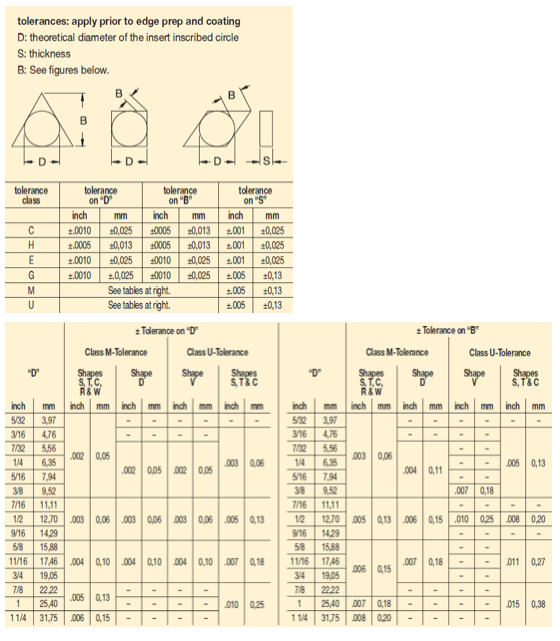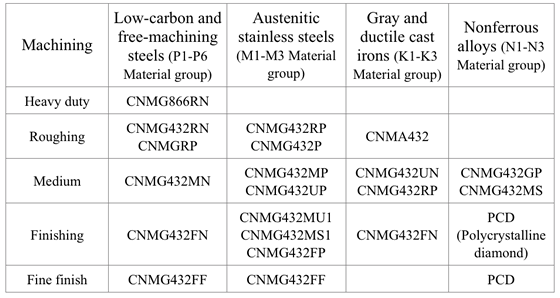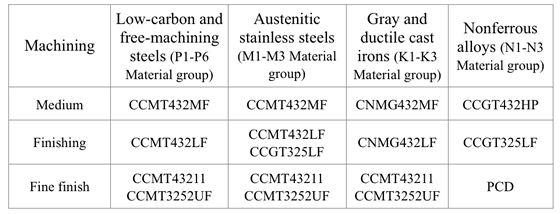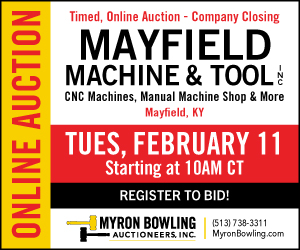This is the original 2014 version of Understanding the Identification System for Indexable Inserts by Edmund Isakov, Ph.D. For an expanded, web-optimized edition with additional insights, updates, and an interactive webform for insert identification, read this version.
American National Standard ANSI B212.4-2002 covers the identification system for indexable-type inserts for both single-point and multiple-point cutting tools. It was published on October 29, 2002. The earlier editions of the standard are:
- ANSI B212.12.1-1995, Indexable Screw-On Inserts with Partly Cylindrical Fixing Holes
- ANSI B212.12-1991, Turning Tools – Commonly Used Indexable Inserts (ANSI – American National Standard Institute)
According to ANSI B212.4-2002 standard, identification of the indexable insert includes 10 positions denoted by a capital letter. Each position (from 1 to 10) defines a characteristic of the insert in the following order:
-
- – Shape;
- – Clearance;
- – Tolerance class;
- – Type;
- – Size;
- – Thickness;
- – Cutting-point configuration;
- – Edge preparation;
- – Hand;
- – Facet size.
1. Shape
There are 16 standard shapes of indexable inserts, and each shape is identified by a capital letter as follows (Figure 1):
A – Parallelogram 85°;
B – Parallelogram 82°;
C – Diamond 80° (Rhombic);
D – Diamond 55° (Rhombic);
E – Diamond 75° (Rhombic);
H – Hexagon 120°;
K – Parallelogram 55°;
L – Rectangle 90°;
M – Diamond 86° (Rhombic);
O – Octagon 135°;
P – Pentagon 108°;
R – Round;
S – Square 90°;
T – Triangle 60°;
V – Diamond 35° (Rhombic);
W – Trigon 80°.
![]()

Figure 1: Kennametal Inc. Insert Shape Identification System. Image courtesy of Edmund Isakov.
![]()
2. Clearances (relief angles)
Nine relief angle values have been described in ANSI B212.12-1991 standard. These angles are the difference from 90° measured in a plane normal to the cutting edge generated by the angle between the flank and top surface of the insert. Each relief angle is denoted by a capital letter as follows:
A – 3°;
B – 5°;
C – 7°;
D – 15°;
E – 20°;
F – 25°;
G – 30°;
N – 0°;
and P – 11°.
ANSI B212.4-2002 standard added one more capital letter O, which denotes other relief angles for new designs of indexable inserts.
3. Tolerance class
There are 14 tolerance classes that control the indexability of the inserts. Each class is denoted by a capital letter. Letters for tolerances are A, B, C, D, E, F, G, H, J, K, L, M, U and N.
Tolerances on dimensions (± from nominal) are denoted by letters A, B and T. Dimension A is the nominal inscribed circle (I.C.) of the insert. Dimension T is the thickness of the insert. For pentagon, triangle and trigon shapes, dimension B is the insert height, i.e., the distance between one side and the opposite corner (Figure 2).
For all other polygons, dimension B is the distance, measured along the bisector of the rounded off corner angle and a gage roll of nominal I.C. size tangent to the two sides opposite the corner (Figure 2). For example, if a tolerance letter is H, tolerances on dimensions (± from nominal) are: 0.0005" on dimension A, 0.0005" on dimension B and 0.001" on dimension T.
![]()

Figure 2: Kennametal Inc. Tolerance Identification System. Image courtesy of Edmund Isakov.
![]()
4. Type
The fourth position is a capital letter denoting differences in design of insert, such as the existence of fixing holes, countersinks and special features on rake surfaces. There are 15 standard types in design as follows (Figure 3):
A – With hole, without chip grooves;
B – With hole, without chip grooves, and one countersink (70°-90°);
C – With hole, without chip grooves, and two countersinks (70°-90°);
F – Without hole with chip grooves on two rake faces;
G – With hole and chip grooves on two rake faces;
H – With hole, one countersink (70°-90°) and chip groove on one rake face;
J – With hole, two countersinks (70°-90°) and chip grooves on two rake faces;
M – With hole and chip groove on one rake face;
N – Without hole, without chip grooves;
Q – With hole, without chip grooves, and two countersinks (40°-60°);
R – Without hole with chip groove on one rake face;
T – With hole, one countersink (40°-60°) and chip groove on one rake face;
U – With hole, two countersinks (40°-60°) and chip grooves on two rake faces;
W – With hole, without chip grooves, and one countersink (40°-60°);
X – With dimensions or details requiring detailed explanation, a sketch or additional specifications.
![]()

Figure 3: Kennametal Inc. Insert Type Identification. Image courtesy of Edmund Isakov.
![]()
5. Size
The fifth position is a significant one- or two-digit number indicating the size of the inscribed circle (I.C.) for all inserts having a true I.C. such as Round, Square, Triangle, Trigon, Pentagon, Hexagon, Octagon, and Diamond. This position designates the number of eighths of an inch in the nominal size of the I.C. It will be a one-digit number when the number of eighths of an inch in the I.C. is a whole number: 1 – 1 ⁄ 8"; 2 – 1 ⁄ 4"; 3 – 3 ⁄ 8"; 4 – 1 ⁄ 2"; 5 – 5 ⁄ 8"; 6 – 3 ⁄ 4"; 7 – 7 ⁄ 8";
8 – 1"; 10 – 1-1 ⁄ 4".
It will be a two-digit number carried to one decimal place when it is not a whole number: 1.2 – 5 ⁄ 32"; 1.5 – 3 ⁄ 16"; 1.8 – 7 ⁄ 32"; 2.5 – 5 ⁄ 16".
On rectangular and parallelogram inserts, the width and length dimensions are used in place of the I.C. A two-digit number designates the sizes of these inserts. The first digit indicates the number of eighths of an inch in the width and the second digit indicates the number of fourths of an inch in the length of the insert.
6. Thickness
The sixth position is a significant one- or two-digit number indicating the number of sixteenths of an inch in the thickness of the insert. It is a one-digit number when the number of sixteenths of an inch in the thickness is a whole number: 1 – 1 ⁄ 16"; 2 – 1 ⁄ 8"; 3 – 3 ⁄ 16"; 4 – 1 ⁄ 4"; 5 – 5 ⁄ 16"; 6 – 3 ⁄ 8"; 7 – 7 ⁄ 16"; 8 – 1 ⁄ 2"; 9 – 9 ⁄ 16"; 10 – 5 ⁄ 8".
It is a two-digit number carried to one decimal place when it is not a whole number: 1.2 – 5 ⁄ 64"; 1.5 – 3 ⁄ 32"; 2.5 – 5 ⁄ 32"; 3.5 – 7 ⁄ 32".
7. Cutting-point configuration
The seventh position indicates the cutting point configuration: a radius or a facet. In the case of a radius, the number indicates how many of 1 ⁄ 64 of an inch in the radius: 0 – sharp corner (0.002" max. radius); 0.2 – 0.004"; 0.5 – 0.008"; 1 – 1 ⁄ 64"; 2 – 1 ⁄ 32"; 3 – 3 ⁄ 64"; 4 – 1 ⁄ 16"; 5 – 5 ⁄ 64"; 6 – 3 ⁄ 32"; 7 – 7 ⁄ 64"; 8 – 1 ⁄ 8"; 10 – 5 ⁄ 32"; 12 – 3 ⁄ 16" 14 – 7 ⁄ 32" = 14; 16 – 1 ⁄ 4"; X – Any other corner radius.
In case of a facet, two letters are used. The first letter designates the facet angle: A – 45°; D – 60°; E – 75°; G – 87°; P – 90°; Z – Any other facet angle. The second letter designates the facet clearance angle:
A – 3°; B – 5°; C – 7°; D – 15°; E – 20°; F – 25°; G – 30°; N – 0°; P – 11°; Z – Any other facet clearance angle.
8. Edge preparation
The eighth position is a capital letter that defines edge treatment and surface finish as follows:
A – Honed from 0.0005 to less than 0.003 inch
B – Honed from 0.003 to less than 0.005 inch
C – Honed from 0.005 to less than 0.007 inch
E – Rounded Cutting Edge
F – Sharp Cutting Edge
J – Polished to 4 micro inch finish AA (arithmetic average) on Rake face only
K – Double Chamfered Cutting Edge
P – Double Chamfered and Rounded Cutting Edge
S – Chamfered and Rounded Cutting Edge
T – Chamfered Cutting Edge on Rake face only
9. Hand
The ninth position is a capital letter indicating the hand of an insert: R – Right Hand; L – Left Hand; N – Neutral.
10. Facet size
The 10th position is only used if there are letters in the seventh position. It will be a significant number representing the nominal sixty-fourths of an inch in length of the primary facet: 1 – 1 ⁄ 64"; 2 – 1 ⁄ 32"; 3 – 3 ⁄ 64"; 4 – 1 ⁄ 16"; 5 – 5 ⁄ 64"; 6 – 3 ⁄ 32"; 7 – 7 ⁄ 64"; 8 – 1 ⁄ 8"; 9 – 9 ⁄ 64"; 10 – 5 ⁄ 32".
![]()

Example identification chart of the indexable insert (Inch Mode). Image courtesy of Edmund Isakov.
![]()
Inserts selection depends on workpiece material, chip control, surface finish, tool life, and the machine tool’s power and torque requirements. One of the commonly used indexable inserts for general turning is CNMG 432.
Due to the magazine’s space limitations, the authors provide the following tables showing most popular Kennametal’s indexable inserts only for general turning of steel, cast iron, and nonferrous alloys. These tables don’t cover all Kennametal chip breakers. (Figure 4 and Figure 5 also show Kennametal Inc. insert identification system and chip breaker identification system respectively.)
![]()
Table 1: Negative indexable inserts. Image courtesy of Edmund Isakov.

![]()
Table 2: Positive indexable inserts. Image courtesy of Edmund Isakov.

![]()

Figure 4: Kennametal Inc. Insert Identification System (Metric Mode). Image courtesy of Edmund Isakov.
![]()

Figure 5: Kennametal Inc. Chip Breaker Identification System. Image courtesy of Edmund Isakov.
![]()

Figure 6: Kennametal Inc. Negative and Positive Inserts. Image courtesy of Edmund Isakov.
![]()
About the Authors: Edmund Isakov, Ph.D., is a consultant, writer, and frequent CTE contributor. He is the author of four books “Mechanical Properties of Work Materials” (Modern Machine Shop Publications, 2000); “Engineering Formulas for Metalcutting” (Industrial Press, 2004); “Cutting Data for Turning of Steel” (Industrial Press, 2009); “International System of Units (SI)” the CD-ROM (Industrial Press, 2013); and the software “Advanced Metalcutting Calculators” (Industrial Press, 2005). For more information, call (561) 369-4063, or email: edmundisakov9701@comcast.net. Shi ‘Steve’ Chen is Manager Product Engineering Turning at Kennametal Inc. For more information, call (724) 539-5321, or email: Shi.Chen@Kennametal.com
Related Glossary Terms
- alloys
alloys
Substances having metallic properties and being composed of two or more chemical elements of which at least one is a metal.
- arithmetic average ( AA)
arithmetic average ( AA)
The mathematical expression denoting one of several parameters that describe surface texture (same as average roughness Ra). Average roughness is the arithmetic average height deviation of the measured surface profile from the profile centerline. See surface texture.
- clearance
clearance
Space provided behind a tool’s land or relief to prevent rubbing and subsequent premature deterioration of the tool. See land; relief.
- countersink
countersink
Tool that cuts a sloped depression at the top of a hole to permit a screw head or other object to rest flush with the surface of the workpiece.
- indexable insert
indexable insert
Replaceable tool that clamps into a tool body, drill, mill or other cutter body designed to accommodate inserts. Most inserts are made of cemented carbide. Often they are coated with a hard material. Other insert materials are ceramic, cermet, polycrystalline cubic boron nitride and polycrystalline diamond. The insert is used until dull, then indexed, or turned, to expose a fresh cutting edge. When the entire insert is dull, it is usually discarded. Some inserts can be resharpened.
- inscribed circle ( IC)
inscribed circle ( IC)
Imaginary circle that touches all sides of an insert. Used to establish size. Measurements are in fractions of an inch and describe the diameter of the circle.
- mechanical properties
mechanical properties
Properties of a material that reveal its elastic and inelastic behavior when force is applied, thereby indicating its suitability for mechanical applications; for example, modulus of elasticity, tensile strength, elongation, hardness and fatigue limit.
- metalcutting ( material cutting)
metalcutting ( material cutting)
Any machining process used to part metal or other material or give a workpiece a new configuration. Conventionally applies to machining operations in which a cutting tool mechanically removes material in the form of chips; applies to any process in which metal or material is removed to create new shapes. See metalforming.
- rake
rake
Angle of inclination between the face of the cutting tool and the workpiece. If the face of the tool lies in a plane through the axis of the workpiece, the tool is said to have a neutral, or zero, rake. If the inclination of the tool face makes the cutting edge more acute than when the rake angle is zero, the rake is positive. If the inclination of the tool face makes the cutting edge less acute or more blunt than when the rake angle is zero, the rake is negative.
- relief
relief
Space provided behind the cutting edges to prevent rubbing. Sometimes called primary relief. Secondary relief provides additional space behind primary relief. Relief on end teeth is axial relief; relief on side teeth is peripheral relief.
- tolerance
tolerance
Minimum and maximum amount a workpiece dimension is allowed to vary from a set standard and still be acceptable.
- turning
turning
Workpiece is held in a chuck, mounted on a face plate or secured between centers and rotated while a cutting tool, normally a single-point tool, is fed into it along its periphery or across its end or face. Takes the form of straight turning (cutting along the periphery of the workpiece); taper turning (creating a taper); step turning (turning different-size diameters on the same work); chamfering (beveling an edge or shoulder); facing (cutting on an end); turning threads (usually external but can be internal); roughing (high-volume metal removal); and finishing (final light cuts). Performed on lathes, turning centers, chucking machines, automatic screw machines and similar machines.











